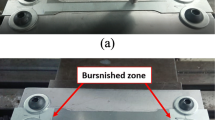Abstract
In this paper, a novel finishing process, which integrates the merits of electrochemical smoothing (ECS) and roller burnishing (RB) for minimizing the roundness error and increasing surface micro-hardness of cylindrical parts, is proposed. Through simple equipment attachments, electrochemical smoothing–roller burnishing (ECS–RB) can follow the turning process on the same machine. To explore the optimum combinations of the ECS–RB process parameters in an efficient and quantitative manner, the experiments were designed on the basis of the response surface methodology technique. The effect of ECS–RB parameters, namely, burnishing force, applied voltage, inter-electrode gap, and workpiece rotational speed on the roundness error and surface micro-hardness was studied. From the multi-objective optimization, the optimal combination of parameter settings are burnishing force of 350 N, applied voltage of 8.2 V, inter-electrode gap of 2.75 mm, and rotational speed of 970 rpm for achieving the required lower roundness error and higher surface micro-hardness. Surface micro-hardness considerably increases about 31.5% compared to the initial surface micro-hardness, and about 2.32 μm roundness error can be achieved using the optimum combination of process parameters. Therefore, the combination of ECS and RB is a feasible process by which it potentially reduces roundness error and surface micro-hardness of axis-symmetric parts improving their reliability and wear resistance.
Similar content being viewed by others
References
Philip K, Lewis L, Sais J (1999) Study of intelligent prediction control of surface roughness in grinding. Int J Mach Tools Manuf 39:1451–1470 doi:10.1016/S0890-6955(99)00002-4
Kozak J, Rajurkar KP (2000) Hybrid machining process evaluation and development. Keynote Paper, Proc. 2nd Int. Conf. on Machining and Measurements of Sculptured Surfaces, Kraków, Poland:501–536
Kozak J, Oczo KE (2001) Selected problems of abrasive hybrid machining. J Mater Process Technol 109(3):360–366 doi:10.1016/S0924-0136(00)00824-4
Pajak PT, De Silva AM, Harrison DK, Mcgeough JA (2006) Precision and efficiency of laser assisted jet electrochemical machining. Precis Eng 30(3):288–298 doi:10.1016/j.precisioneng.2005.09.006
Pajak PT, De Silva AM, McGeough JA, Harrison DK (2004) Modeling the aspects of precision and efficiency in laser-assisted jet electrochemical machining (LAJECM). J Mater Process Technol 149(3):512–518 doi:10.1016/j.jmatprotec.2003.10.055
EL-Taweel TA (2008) Modeling and analysis of hybrid electrochemical turning-magnetic abrasive finishing of 6061 Al/Al2O3 composite. Int J Adv Manuf Technol doi:10.1007/s00170-007-1019-7
Yasunaga N (1997) Recent advances in ultra-precision surface finishing technologies in Japan. In: Proceedings of the international symposium on advances in abrasive technology Sydney: 18–27
Lee S, Lee Y, Chung M (2006) Metal removal rate of the electrochemical mechanical polishing technology for stainless steel—the electrochemical characteristics. Proc Inst Mech Eng Part B: J Eng Manuf 220:525–530
Tehrani AF, Atkinson J (2000) Overcut in pulsed electrochemical grinding. Proc Inst Mech Eng Part B: J Eng Manuf 214:259–269
Pa PS (2008) Synchronous finishing processes using a combination of grinding and electrochemical smoothing on end-turning surfaces. Int J Adv Manuf Technol. doi:10.1007/s00170-007-1329-9
Luo H, Liu J, Wang L, Zhong Q (2006) The effect of burnishing parameters on burnishing force and surface micro-hardness. Int J Adv Manuf Technol 28:707–713 doi:10.1007/s00170-004-2412-0
Luo H, Liu J, Wang L, Zhong Q (2005) Investigation of the burnishing process with PCD tool on non-ferrous metals. Int J Adv Manuf Technol 25:454–459 doi:10.1007/s00170-003-1959-5
Luca L, Neagu-Ventzel S, Marinescu I (2005) Effects of working parameters on surface finish in ball-burnishing of hardened steels. Precis Eng 29:253–256 doi:10.1016/j.precisioneng.2004.02.002
Ebeid SJ, El-Taweel TA (2005) Surface improvement through hybridization of electrochemical turning and roller burnishing based on the Taguchi technique. Proc Inst Mech Eng Part B: J Eng Manuf 219:432–438
El-Taweel TA, Ebeid SJ (2007) Improvement of roundness of cylindrical parts using hybrid electrochemical smoothing and roller burnishing process. Proceedings of the 35th International MATADOR Conference, Taiwan, 18–20 July: 85–88
Rumyantsev E, Davydov A (1989) Electrochemical machining of metals. Mir Publication, Moscow
Montgomery DC (2001) Design and analysis of experiments. Wiley, New York
Ebeid SJ, Hewidy MS, El-Taweel TA, Youssef AH (2004) Towards higher accuracy for ECM hybridized with low frequency vibrations using the response surface methodology technique. J Mater Process Technol 149(1):428–434 doi:10.1016/j.jmatprotec.2003.10.046
Munda J, Bhattacharyya B (2007) Investigation into electrochemical micromachining (EMM) through response surface methodology based approach. Int J Adv Manuf Technol. doi:10.1007/s00170-006-0759-0
McGeough JA (1988) Advanced methods of machining. Chapman and Hall, New York
Sen M, Shan HS (2005) Analysis of hole quality characteristics in the electro jet drilling process. Int J Mach Tools Manuf 45(15):1706–1716 doi:10.1016/j.ijmachtools.2005.03.005
Hofstede A, Brekel J (1970) Some remarks on electrochemical turning. CIRP Ann 18:93–106
Derringer G, Suich R (1980) Simultaneous optimization of several response variables. J Qual Technol 12:214–219
Castillo ED, Montgomery DC, McCarville DR (1996) Modified desirability functions for multiple response optimization. J Qual Technol 28:337–345
Author information
Authors and Affiliations
Corresponding author
Rights and permissions
About this article
Cite this article
El-Taweel, T.A., Ebeid, S.J. Effect of hybrid electrochemical smoothing–roller burnishing process parameters on roundness error and micro-hardness. Int J Adv Manuf Technol 42, 643–655 (2009). https://doi.org/10.1007/s00170-008-1632-0
Received:
Accepted:
Published:
Issue Date:
DOI: https://doi.org/10.1007/s00170-008-1632-0




